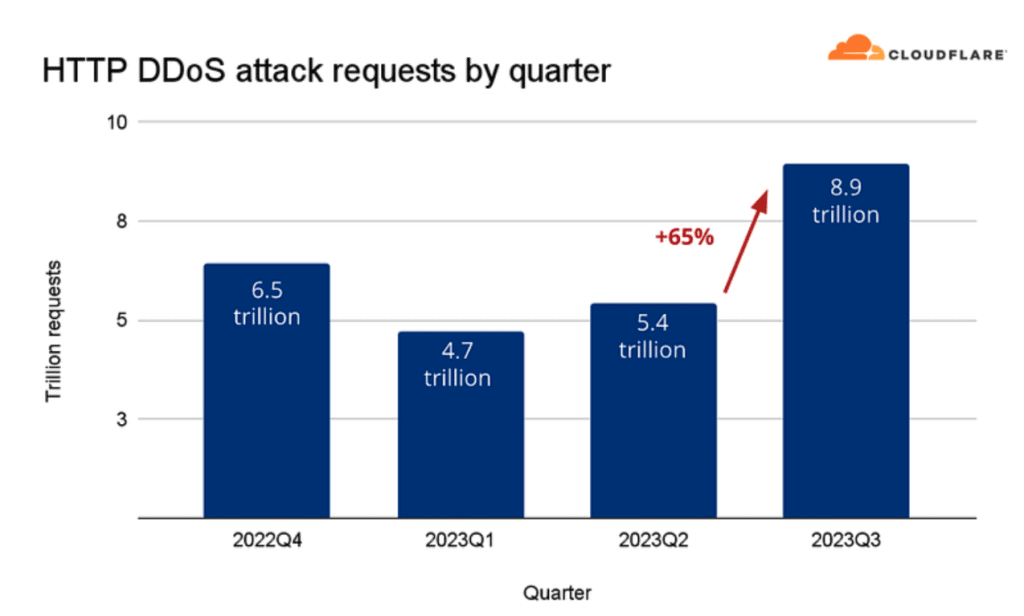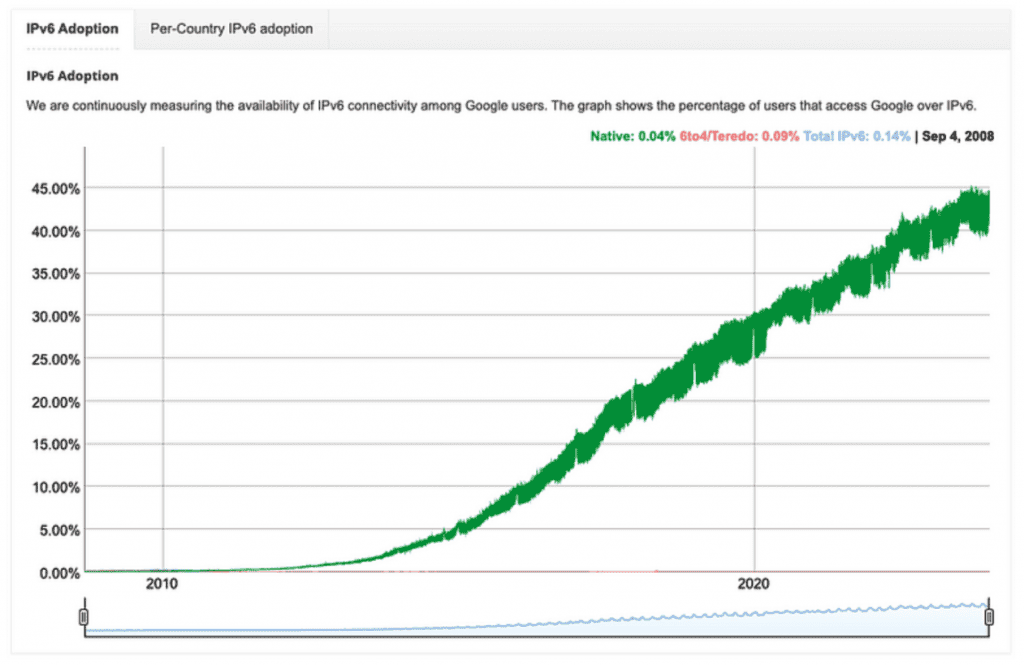Are we not in an ever-more-dynamic world of cybersecurity? With advancements in AI, cloud technology, IoT, and various other IT breakthroughs, cyber attacks like DDoS are constantly evolving. These aren’t just growing in number; their sophistication is also increasing, making them increasingly indistinguishable from legitimate human traffic. At Mlytics Security Operation Center (SOC), we’re deeply fascinated by this evolving landscape. We’re eager to contribute to the cybersecurity community, and so, we’d like to share our insights on the 2023 attack trends and what we expect for the challenges that 2024 may bring.
2023: Record-Breaking Attacks
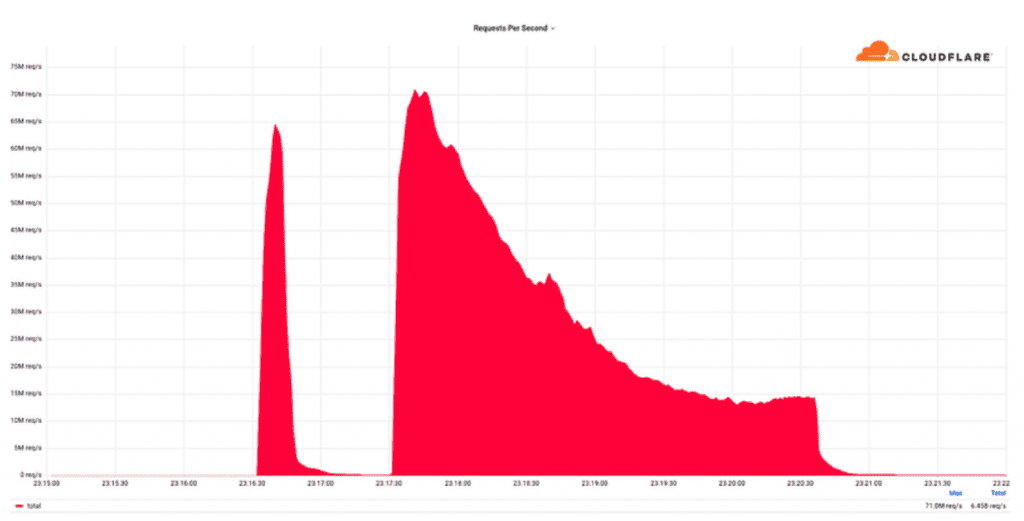
In 2023 at Mlytics, we observed a notable increase in both the frequency and size of DDoS attacks, a trend we believe wasn’t unique to us but prevalent across various service providers in different industries. A prime example was the groundbreaking attack reported by Cloudflare, peaking at an astonishing 71 million requests per second, a 54% increase from 2022’s record. This attack, emerging from a network of over 30,000 IP addresses, showcased unprecedented scale and coordination, marking a significant escalation in the intensity of HTTP DDoS attacks and highlighting an alarming trend in cyber threats.
For more details on this, you can refer to Cloudflare’s report: Cloudflare Mitigates Record-Breaking DDoS Attack.
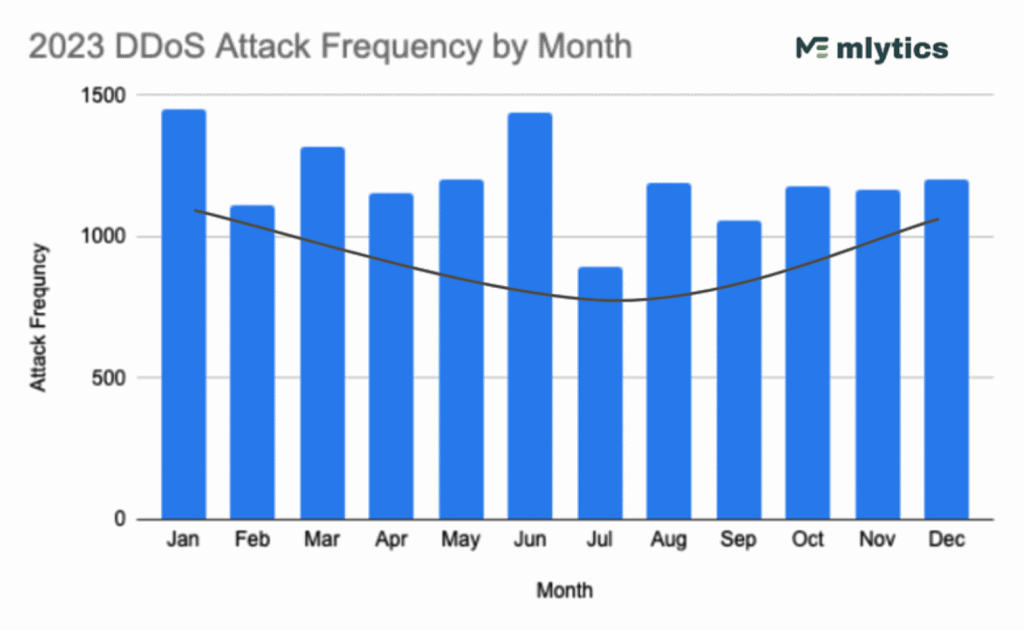
Mlytics: A Case Study in Smaller-Scale Attacks
Not long ago, in late 2023, Mlytics SOC dealt with a Layer 7 DDoS attack targeting a domain, which experienced 8 million requests per minute. The domain, having suffered multiple attacks before adopting Mlytics’ protection, struggled to cope with these assaults. This incident, though smaller in scale compared to Cloudflare’s largest attacks, demonstrates how even less intense DDoS attacks can profoundly disrupt services. It highlights the vulnerability of servers without robust protection and underscores the need for preparedness against all types of DDoS threats.
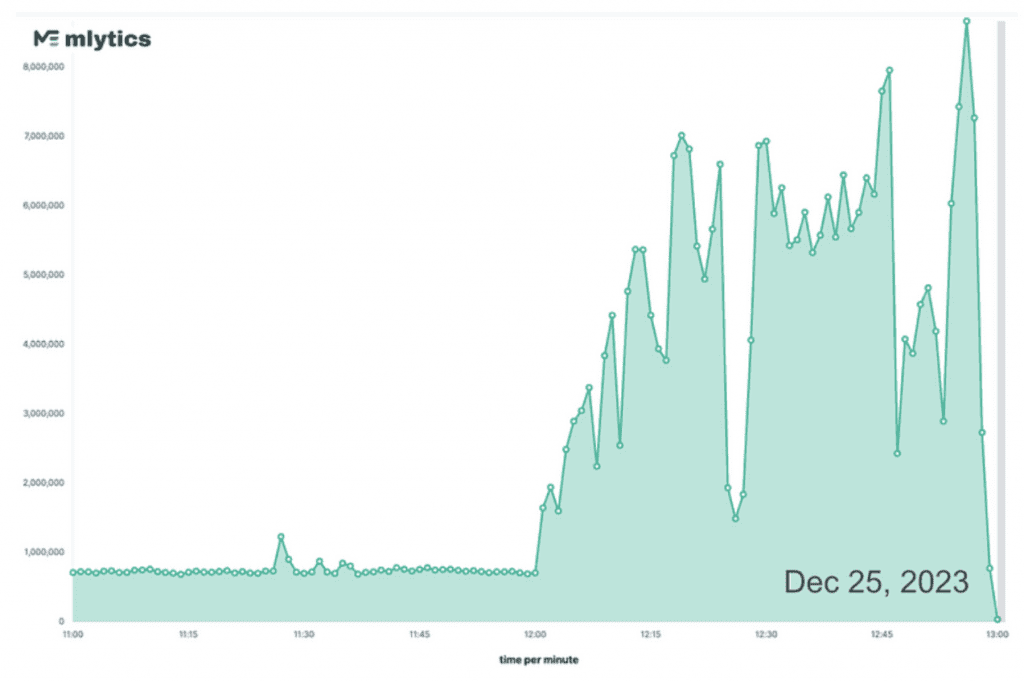
The Role of AI in DDoS Attacks
Let’s talk again about our experience in 2023 when handling the DDoS attack. During our DDoS attack handling in 2023, we grew suspicious of AI’s role due to the attacks’ complexity and precision. These attacks displayed patterns and adaptations that seemed beyond typical automated methods, suggesting the possibility of AI-driven orchestration. This level of sophistication in mimicking legitimate user behavior and adapting to defensive measures hinted at advanced algorithms potentially powered by AI. However, without concrete data, this remains a well-founded suspicion rather than a confirmed fact.
Anyway, our suspicion of this AI-driven attack signals a move towards more complex and adaptive cyber threats. AI-driven attacks are particularly tricky to identify as they can mimic normal traffic, making automatic detection and blocking more challenging. While we don’t have concrete data to confirm AI’s role in the DDoS attacks in 2023, the possibility is concerning. As AI continues to develop, our defensive strategies must evolve in tandem to effectively counter these advanced threats.
Predictions for 2024: The Evolving Landscape of DDoS Attacks
Stepping into 2024, we’re noticing a major shift in the cybersecurity world. The ever-growing number of IoT devices is like a double-edged sword. While they bring convenience, their rapid proliferation offers cyber attackers a wider array of targets. Many of these devices lack strong security, making them easy picks for hackers.
According to the mid-year update to the 2023 SonicWall Cyber Threat Report, in the first six months of 2023, IoT malware globally was up by 37%, resulting in a total of 77.9 million attacks, compared to 57 million attacks in the first six months of 2022.
Reference: https://iotac.eu/iot-malware-attacks-up-by-37-in-the-first-half-of-2023/
Then there’s IPv6, with its enormous address space, connecting more devices to the internet than ever before. This increase in online devices not only boosts internet traffic but also expands the potential targets for cyber attacks. IPv6’s direct addressing feature adds another layer of complexity, possibly leading to more intense DDoS attacks. We’re gearing up for these new challenges in a broader, more connected digital landscape.
Our prediction for 2024 includes not only the involvement of AI in attacks but also the expectation that IoT botnets will become more advanced and powerful, potentially leading to massive DDoS attacks. These botnets, utilizing numerous compromised devices, could disrupt services on a global scale. To summarize our predictions:
- Larger Scale Attacks: More IoT devices and IPv6 usage will likely result in bigger, more complex DDoS attacks.
- Targeted IoT Exploits: Hackers are expected to refine methods for exploiting IoT vulnerabilities.
- Adaptive Tactics: Attackers may use AI to enhance their attack strategies.
- Increased Frequency: The ease of orchestrating attacks with IoT botnets could lead to more frequent attacks.
- Additionally, a Rise in State-Sponsored Attacks: Geopolitical tensions might also escalate the use of DDoS attacks in digital warfare.
Preparing for the Future: Strengthening Defenses Against DDoS Attacks
So, considering our experiences in 2023 and the predictions for 2024, should you be aware and prepared for these DDoS threats? The simple answer is an emphatic YES!
Given the evolving nature of DDoS attacks in 2024, both organizations and individuals need to implement comprehensive and proactive strategies to minimize these risks.
What steps can be taken? Here are some key approaches:
Implementing multi-CDN strategies to bolster DDoS defenses.
Why multi-CDN? Because multi-CDN strategies are crucial, especially for web-based services. They distribute web traffic across multiple CDNs, improving not only load times and global accessibility but also resilience against DDoS attacks. By spreading traffic across various CDNs, multi-CDN maximizes each network’s ability to absorb and mitigate large-scale attacks, thereby reducing the risk of a single point of failure. This approach enhances overall website performance and security.
Utilizing enhanced detection systems.
The enhanced detection systems involve deploying advanced technologies to identify and respond to DDoS threats more effectively. These systems are typically designed to recognize unusual traffic patterns and potential threats quickly. By using sophisticated algorithms and sometimes incorporating AI and machine learning, they can distinguish between normal and malicious traffic with greater accuracy. This early detection is crucial in mitigating the impact of DDoS attacks, allowing for prompt and appropriate responses to secure the network and protect assets. Enhanced detection systems are a key component in a modern, layered cybersecurity strategy.
Conducting regular security audits and updates.
Conducting regular security audits and updates is about continuously assessing and improving the security infrastructure. Regular audits help identify vulnerabilities in the system before attackers can exploit them. This process involves examining the effectiveness of existing security measures and updating them to address new threats. Regular updates ensure that all software and systems are equipped with the latest security patches, minimizing the risk of breaches. This proactive approach is essential for maintaining robust defense against evolving cyber threats, including DDoS attacks.
Engaging in community collaboration and intelligence sharing.
Engaging in community collaboration and intelligence sharing involves participating in broader cybersecurity networks. By sharing information about threats, attack patterns, and effective defense strategies with other organizations and cybersecurity communities, everyone becomes better equipped to handle new threats. This collaborative approach enhances the collective understanding and response to cyber threats like DDoS attacks. Sharing insights and learning from others’ experiences strengthens defenses across the board, making it harder for attackers to exploit vulnerabilities that are commonly known and addressed within the community.
Well, we realize the importance of this point. That is also one of the reasons why we are sharing this content with everyone. Therefore, please also share your thoughts with put your comments on this article 😉
Training and educating staff.
Training and educating staff is a proactive step in cybersecurity. It involves regularly updating the team on the latest cyber threats, like DDoS attacks, and best practices for defense. This education helps staff recognize potential threats, understand the importance of security protocols, and respond effectively. A well-informed team is a critical line of defense, as human error can often be a vulnerability exploited by attackers. Ongoing training ensures that all team members are equipped with the knowledge to maintain a strong cybersecurity posture.
As we conclude our journey through the evolving world of cybersecurity, remember: that predicting the exact nature of DDoS attacks is a complex task. Yet, staying prepared and informed about the latest trends and defense strategies is key. Organizations need to be vigilant and proactive, continually updating their cybersecurity measures to face the changing threat landscape. So, stay alert, stay informed, and always be one step ahead in this ongoing battle against cyber threats.
In conclusion, as the cybersecurity landscape evolves, Mlytics SOC stands as a beacon of preparedness and collaboration. Our commitment extends beyond insights and predictions to practical support for enterprises navigating these challenges.
For enterprises seeking robust defense mechanisms and proactive strategies, Mlytics SOC Enterprise support team stands ready. With tailored solutions and expert guidance, we empower organizations to fortify their defenses against evolving cyber threats.
As we journey forward, let us not only anticipate the future but actively shape it. Together, with Mlytics SOC Enterprise support, let’s navigate the ever-changing cybersecurity landscape with confidence and resilience.
Author’s Note
As cybersecurity engineers, we’ve been closely monitoring DDoS trends and their implications. This prediction for 2024 is based on data available up to 2023 and aims to contribute to the community so everyone can be ready and strengthen their defenses against potential future attacks.

